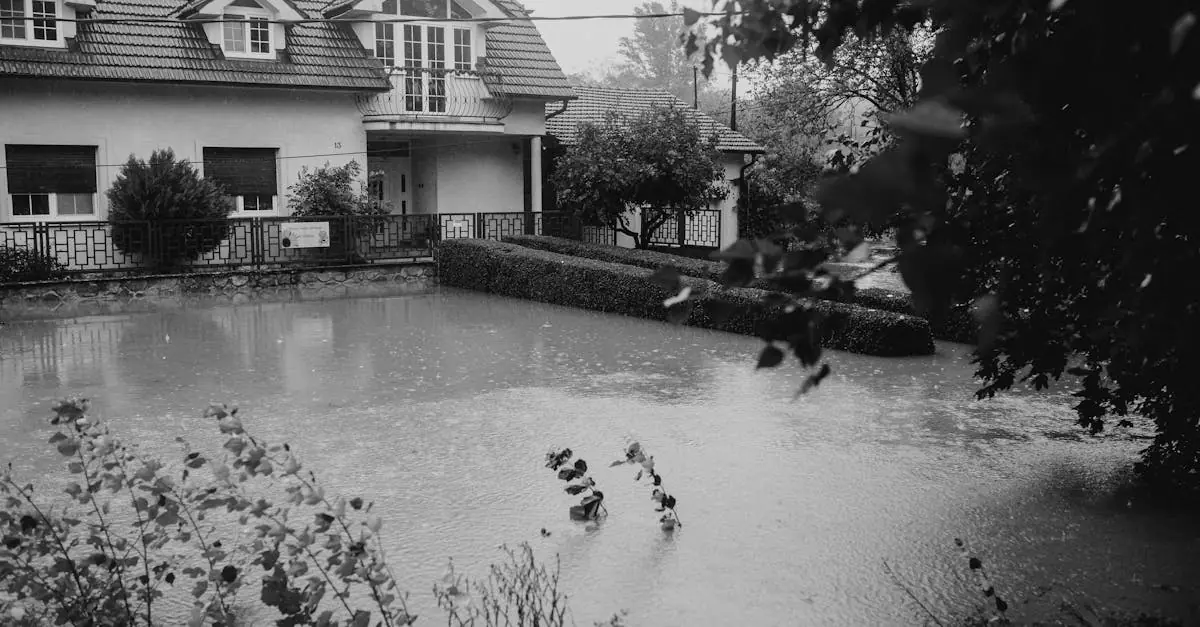Table of Contents
ToggleHomeownership can feel like a never-ending game of whack-a-mole, and just when you think you’ve got everything under control, those sneaky termites decide to throw a wrench in the works. These tiny wood-chomping villains can turn your dream home into a nightmare faster than you can say “pest control.” But before you panic and start Googling “how to build a fortress,” it’s time to tackle the big question: is termite damage covered by homeowners insurance?
Understanding Homeowners Insurance
Homeowners insurance protects against various risks, including damage to the structure and personal property. Coverage usually includes hazards like fire, theft, and certain types of water damage. Notably, coverage terms can differ based on the policy.
Policies often contain specific exclusions, which could impact how claims are handled. For example, most homeowners insurance policies may exclude damage resulting from termites or other pests. Homeowners typically face significant out-of-pocket expenses if termites compromise the integrity of the home.
Terminology can be confusing. Actual cash value and replacement cost are common terms. Actual cash value factors in depreciation while replacement cost covers the full cost without depreciation deducted. Homeowners need to understand these distinctions when considering policy options.
Insurance providers emphasize the importance of regular maintenance. Regular inspections can identify potential termite issues before they worsen. Many companies recommend specific preventative measures, such as professional pest treatments and proper landscaping.
Reviewing the fine print in insurance policies proves essential. Some might offer riders or endorsements to add additional coverage for pest damage. Homeowners can benefit from consultations with insurance agents to clarify coverage regarding termite damage.
Understanding homeowners insurance requires careful examination and ongoing engagement with policy details. Homeowners should remain proactive about minimizing risks associated with termite damage through maintenance and careful policy selection.
Termite Damage Explained
Termites cause significant damage to homes, often leading to costly repairs. Understanding the types of damage they inflict and recognizing the signs of their presence is crucial.
Types of Termite Damage
Subterranean termites primarily damage wooden structures. Wood foundations, beams, and furniture often fall victim to their insatiable appetite. Drywood termites, on the other hand, infest untreated wood above ground. These pests can weaken support beams and ceilings, posing serious safety risks. Damage can manifest as hollowed wood, visible tunnels, or frass, which is termite droppings. Structural integrity may suffer as infestations go unchecked. Repair costs can escalate quickly, making early detection vital.
Signs of Termite Infestation
Several signs indicate a potential termite infestation. Homeowners should be vigilant for mud tubes, which termites use for travel and protection. Discolored or blistered paint may suggest hidden damage behind walls. Additionally, soft or hollow-sounding wood indicates termites have compromised the material. Presence of frass, resembling sawdust, is another telltale sign. Winged termites, commonly observed after swarming, also signal an active infestation. Regular inspections can help catch these signs early, preventing severe damage and costly repairs.
Insurance Coverage for Termite Damage
Homeowners insurance provides essential protection against various risks, yet coverage for termite damage often varies. Understanding specific policy details is crucial for homeowners.
Typical Homeowners Insurance Policies
Most standard homeowners insurance policies cover damages caused by fire, storms, and theft. Typical policies, however, often exclude damage resulting from pests such as termites. Coverage typically protects the home’s structure and personal property, yet each policy defines its limits. With many policies, home maintenance and prevention efforts significantly influence coverage availability. Homeowners should routinely review their policies to ensure adequate protection against unforeseen issues.
Exclusions in Coverage
Exclusions in homeowners insurance frequently encompass termite damage. Many policies explicitly state that damage from pests isn’t covered, leading to potential out-of-pocket expenses. Such exclusions can leave homeowners vulnerable, especially when infestations escalate. Understanding specific exclusions helps homeowners prepare for financial impacts. Additionally, some policies may offer limited pest-related coverage, but these options aren’t standard. Homeowners might explore riders or endorsements to enhance coverage against termite damage.
Steps to Take If Termite Damage Occurs
Addressing termite damage requires prompt action. Following a series of steps can significantly help in managing repairs and insurance claims effectively.
Documenting the Damage
First, take clear photographs showing the extent and location of the damage. Snap pictures of visible termite signs, such as mud tubes or frass, to support your case. Include images of damaged wood or structural components. Create a written record detailing observations, including dates and affected areas. This information will be valuable when filing claims. In some cases, it may be beneficial to consult with a pest control professional for an official inspection report.
Contacting Your Insurance Provider
Next, reach out to your insurance provider immediately after identifying termite damage. Provide them with the documentation you’ve gathered, as this information will assist in processing your claim. Be prepared to discuss specific policy details, including coverage limits and exclusions regarding termite damage. Asking questions about potential adjustments or endorsements can clarify available options. Filing claims in a timely manner increases the chances of receiving assistance for repairs. Understanding your policy can lead to more informed discussions with the insurer.
Homeowners need to be proactive when it comes to understanding their insurance coverage regarding termite damage. Most standard policies don’t include protection against pests like termites which can lead to costly repairs. Regular inspections and maintenance are essential to catch infestations early and mitigate damage.
Consulting with an insurance agent can clarify specific coverage details and help homeowners explore riders or endorsements for added protection. By staying informed and taking preventive measures, homeowners can better navigate the risks associated with termite damage and safeguard their investments.





